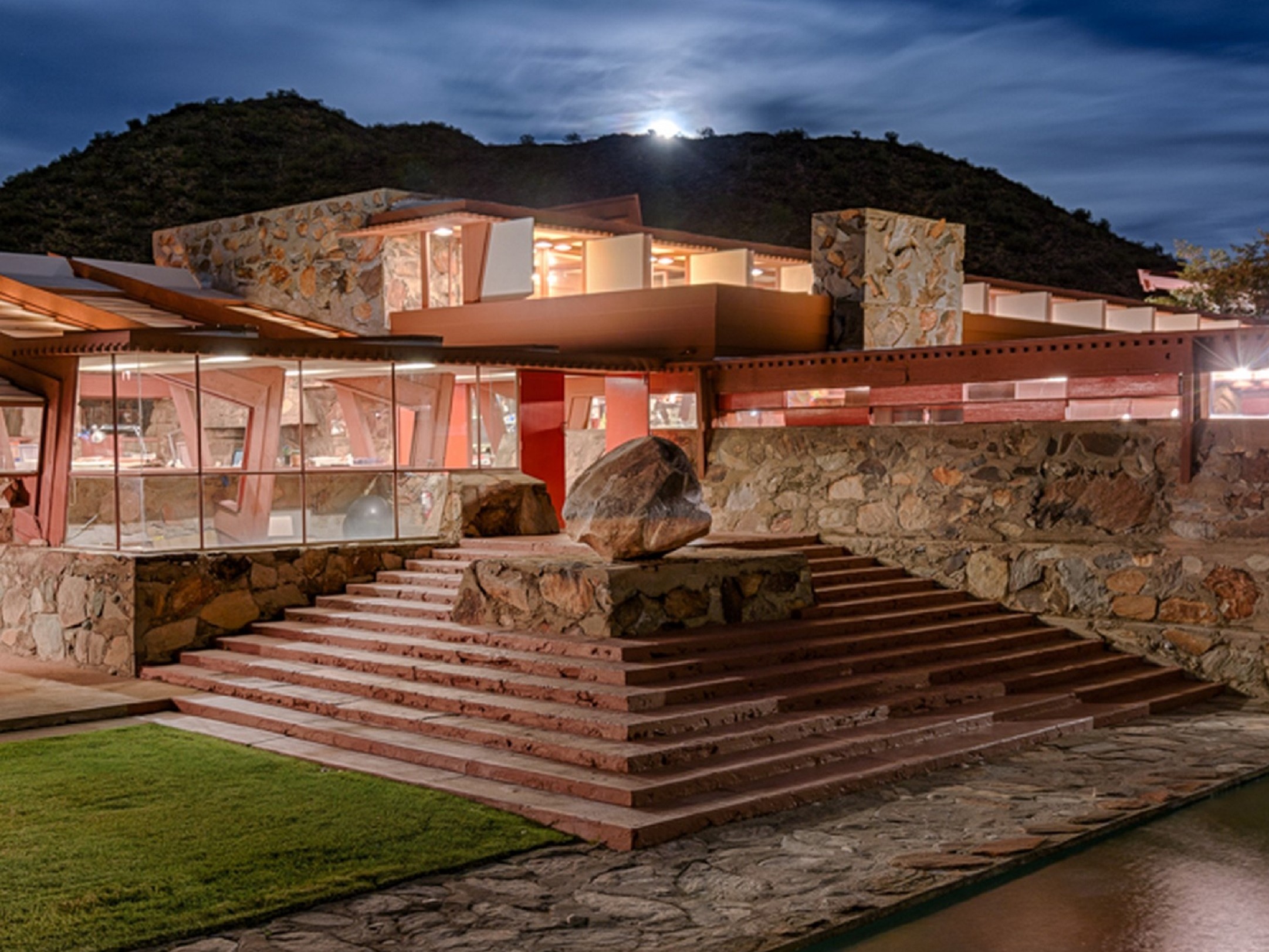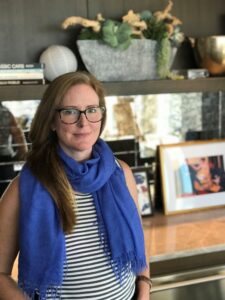Advancing Wright’s Ideas

Writer Joseph J. Airdo // Photography by Andrew Pielage
When most people hear the name Frank Lloyd Wright, they think of his many amazing architectural achievements. From Taliesin West — the iconic architect’s winter home which is nestled right here in the arid foothills of Arizona’s McDowell Mountains — to his vacation home Fallingwater built in 1936 atop a gushing waterfall in southwestern Pennsylvania and the Guggenheim Museum in New York, there is no doubting the accuracy of that association.
However, Wright was on the vanguard of so much more than just architecture. Just as often as he was coming up with innovative ways to transform the spaces in which we live, work and play, he was coming up with innovative ways to transform the space between our ears.
“Frank Lloyd Wright was always trying to use education to improve people’s lives and to advance democracy,” says Jennifer Gray, Ph.D., a noted Wright scholar who recently was the curator of drawings and archives at Columbia University’s Avery Architectural and Fine Arts Library. “That is something that I am really interested in, as well, because I also believe that education is very important for our society and our communities.”
That interest and a body of research that includes how Wright’s mentors used architecture, cities and landscapes to advance social and spatial justice at the turn of the 20th century are just two of the reasons that the Frank Lloyd Wright Foundation has engaged Gray to lead a new collection of programs that will be known as the Taliesin Institute.
The programs are intended for architecture and design students, new and established design professionals and the broader public interested in learning about the history and future of organic architecture principles, which were established as the core of Wright’s work.
The Taliesin Institute will embrace a broad range of work, including the development of a consortium of leading architecture schools that will send students to study at the two Taliesin campuses — Taliesin in Spring Green, Wisconsin and Taliesin West in Scottsdale — with a particular focus on hands-on work aligned with Wright’s insistence on learning by doing.
The institute will also offer public classes, symposia and workshops that reflect the evolving nature of Wright’s principles of organic design and their relevance to the way we live now, and in the future.
Frank Lloyd Wright Foundation president and CEO Stuart Graff says that much more can be done to present Wright’s work than through the current offering of tours and museum engagement programs.
“Wright intended his foundation to perpetuate the field of organic architecture, including training architects in his principles of design,” Graff explains. “Those principles are constantly evolving and changing because they are built around the way we live and embrace new materials, new technologies and a changing culture.”
The foundation has spent the past two years meeting with leaders from architecture schools, design firms and the community to understand how its work could best serve the profession and the public interest while remaining true to the principles of Wright’s body of ideas. Graff believes that Gray is the perfect person to help the foundation expand its efforts based on those findings.
“We are thrilled to bring someone as respected as Jennifer Gray to the foundation to lead this important new initiative, as the scope of her research interests fits brilliantly with the work of the Taliesin Institute,” Graff says.
Social Improvement



Gray first developed an interest in architectural history while in college.
“I started off taking art history classes,” says Gray, noting that she quickly became fascinated with the many ways in which one can use art and architecture as lenses to talk about much larger cultural, political and social subjects.
Over time, Gray’s interest began to lean more toward architecture than paintings, sculptures and other fine arts. She credits her decision to specialize in architecture to the complexity of questions and challenges associated with the construction of a building — such as financing and labor.
“Architectural history is a vehicle to talk about a lot of other things besides just architecture,” she explains. “Architecture is a lens into a much broader set of questions that have to do with the society in which we are living. It leads to discussions about our rules, our laws, our politics, money, power and all of the other things that we, as a society, struggle with on a daily basis.”
Gray’s studies led her to architects Louis Sullivan, Dwight Perkins and Dankmar Adler.
“I just loved their work,” she says. “So I started studying it and I just kept studying it.”
After earning her master’s degree from the University of Illinois at Chicago, Gray moved to New York to pursue her doctorate from Columbia University. When it came time to write her dissertation, Gray chose Perkins as her subject.
“When you are a student, you do not really think that you can say anything new about Frank Lloyd Wright because he is such a well-known architect. He is a household name. And there are literally thousands of books written about the guy.”
Gray was later tapped to curate a large exhibition on Wright at the Museum of Modern Art in 2017. It was through that exhibition that she received the opportunity to spend about a year combing through the Frank Lloyd Wright Foundation Archives, which contain more than one million elements — including Wright’s drawings, writings and photography.
“It made me realize that there are a lot of interesting new and relevant ideas to talk about with regard to Frank Lloyd Wright,” Gray says.
One of Gray’s most fascinating discoveries has been Wright’s commitment to create affordable housing options.
“Frank Lloyd Wright is really well-known for iconic buildings like Fallingwater and the Guggenheim, but he also spent his whole life trying to devise inexpensive housing systems to improve the lives of everyday people,” says Gray, noting his ideas included mail-order catalog and prefabricated houses. “Toward the end of his life, he even tried do-it-yourself housing, where you would actually build a house yourself. None of these really took off in a mass way, but he was always trying.
Gray adds that using architecture as a means of social improvement was just as important to Wright as form — if not more so.
“Wright was always trying to use his architecture to [achieve] affordable housing so that more people could have access to quality places to live,” says Gray, noting that he was also focused on redesigning cities to be cleaner and more green. “He was always using his practice to try to improve people’s lives for the better. He would call it ‘advancing democracy.’ He was very interested in practicing democracy and trying to expand it to include all groups.”
Relevant Applications



Gray says that Wright was also committed to educational reform — a value that was perhaps passed down to him by his aunts who, in 1887, founded the first co-educational boarding school in Wisconsin.
“It was very avant-garde and ahead of its time in terms of the types of curriculum that it offered, such as nature studies and chemistry labs,” Gray says. “Those are now part of our education but were brand new at the time. Wright took that one step further and founded his own school — the Taliesin Fellowship.”
A community of apprentices and their families who lived, worked and studied with Wright, the Taliesin Fellowship provided a total learning environment integrating all aspects of the apprentices’ lives with the intent of educating responsible, creative and cultured human beings.
“They taught architecture there but they also had all other kinds of practices happening — graphic design, fine arts, film studies, performance, dance, literature, philosophy and music,” Gray says. “It was very multifaceted in terms of the kinds of learning that was taking place there. The curriculum was wide-reaching. Wright would say that of all that falls under the umbrella of architecture.”
Hands-on learning was an integral part of the Taliesin Fellowship’s pedagogy. Gray says that a typical day might have consisted of a group breakfast followed by coursework, farming, architectural study, afternoon tea and, finally, a film screening.
“There were a very diverse set of things that you were learning and how you were learning them,” Gray explains. “But the active component was key.”
She suspects that it will also be a key component of the Taliesin Institute.
“We are still in the process of developing the strategic plan but, generally speaking, we want to distill the essence of the Taliesin Fellowship, take its essential qualities and move them into the contemporary moment,” Gray says.
She adds that Wright was also an amateur farmer throughout his entire life and valued nature, farming, food and the environment. She predicts that, given our current climate situation, those things will also play a major part in the educational experience at the Taliesin Institute.
“I also think that it is important for different kinds of learners to come to the institute,” Gray says. “Students who are in a Masters of Architecture program might come to do an exchange program at the Taliesin Institute. We might also have professional architects who can take continuing education credits there.
“We might also have rising seniors come through the summer before their college year. And, ideally, we will also have lifelong learners — people from the general public who are just interested in architecture, Wright or any of the subjects that will be offered at Taliesin Institute.”
In other words, the lessons that the Taliesin Institute aspires to offer will be relevant to a broad range of individuals. After all, the questions that Wright asked and the solutions he proposed had profound impacts on so much more than just architecture. Moreover, they are oftentimes the same discussions or very similar to those that we are having today.
“The historical context of what people thought in the past as well as what worked and did not is a way to grapple with a variety of different problems and apply them to our current situation,” explains Gray, recalling her earlier sentiments about architecture being a lens into a much broader set of societal issues. “It gives you some more tools to actually change your own community and your own society for the better.”
Gray adds that Wright’s questions and solutions are particularly timely at the moment because the social divisions and economic issues that were present in the time that he was working — especially during the early 20th century — are very similar to those that we are experiencing today.
“So I think that his lessons have particularly relevant applications,” she says. “Our solutions might look different now, but [Wright] was already asking them 100 years ago. So I think that it is really interesting to probe how he was tackling those things and how that might help us to tackle them today.”
Gray is therefore eager to see how the Taliesin Institute can help its students to have a positive impact on people’s lives, just as Wright aspired to do many years ago.
“I am very excited to be part of this new venture and look forward to exploring and advancing Wright’s ideas about architecture, education, community, the environment and more and how they remain relevant for us today,” says Gray, who will be under contract with the Frank Lloyd Wright Foundation while she completes other projects and will join the foundation full-time this summer.
“We will use the early months to focus on fleshing out the strategic plan for the institute and then announce specific programs as they are ready to come online. Everything will be done to start with small, focused programs that can be fine-tuned and scaled up as the opportunities allow.”

